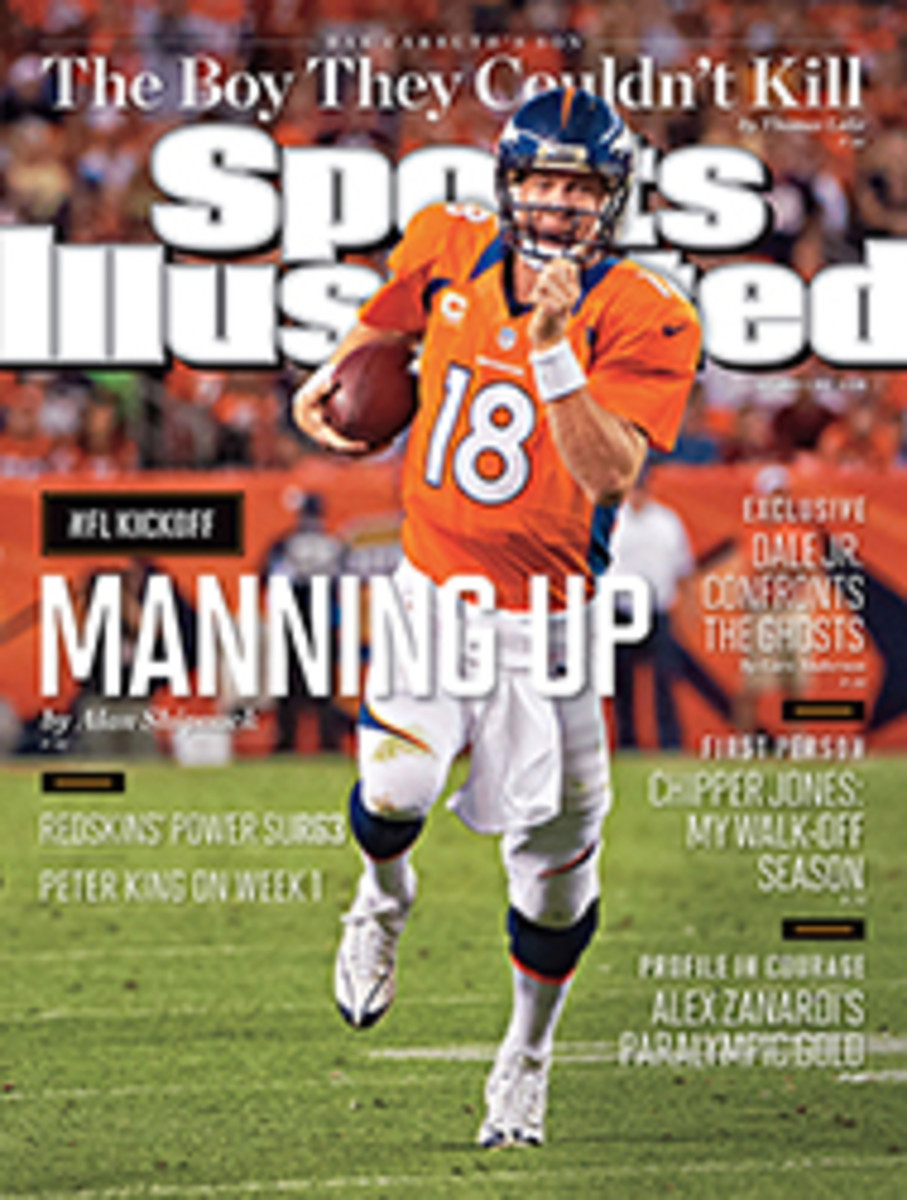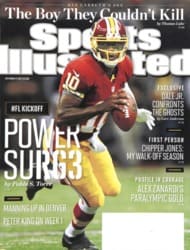
He's So Predictable
Nate Silver, the mind behind the must-read political blog FiveThirtyEight, honed his forecasting skills in the world of sports
Nate Silver, professional predictor, has barely settled into his seat at Yankee Stadium when two straight New York hitters send line drives to the outfield. Each dies in the glove of a diving Oriole, and the groans of the Labor Day weekend crowd tell a larger narrative: Baltimore is closing in on the Yanks, whose lead has shrunk to two games. Yet to Silver these aren't plays so much as data points, and few people know how to make sense of them. "If you're a Yankee fan, 'The ball isn't bouncing our way' isn't enough of an explanation," he says. "They're hitting the hell out of the ball, yet if they lose, people will freak out. Baltimore's catching up, what's wrong? People don't have a good intuitive sense of how to weigh new information in light of what they already know. They tend to overrate it."
Silver is just back from the Republican convention in Tampa, and in a few days he'll be in Charlotte with the Democrats, all for his poll-crunching political blog, FiveThirtyEight. As long as we're talking predictions, here's one: FiveThirtyEight's traffic will increase in advance of the Nov. 6 election, if only because, in 2008, Silver correctly called the electoral college in 49 of 50 states and went 35--0 in the Senate races.
But over the five years before that Silver had a similarly impressive record in baseball with his breakthrough forecasting system, PECOTA. In 2008 it predicted that the Rays, a year after losing 96 games, would win 88. In fact, Tampa Bay wound up winning 97. That, on top of another bold but spot-on call—that the White Sox, after winning 90 games in 2006, would lose 90 the next season—certified his reputation. After Barack Obama's election Silver felt as if he had "won the nerd lottery," as he puts it, popping up everywhere from a TED conference to The Colbert Report. "You'll get recognized on the street," he says. "And because you're not a real celebrity—you're a dork celebrity—people feel free to talk to you."
In conversation Silver often drops an interrogative right?—especially as he goes deeper into an explanation of how he approaches data. That right? sums up what Silver seeks to deliver: a prediction, but with the skepticism signified by that punctuation mark. To err may be human, but Silver believes that we have a range of attributes besides errancy, and many—perspective, humility, prior knowledge—would improve our forecasts, if only we used them. His forthcoming book, The Signal and the Noise: Why So Many Predictions Fail—But Some Don't, celebrates the virtues of probabilistic thinking. It also offers tips for finding meaning amid the cacophony of talk radio and urges us to keep in mind our "Bayesian priors," which is the fancy-Dan phrase logicians use for "what we already know."
In his book Silver profiles a pro basketball bettor named Bob Voulgaris who, after the Lakers got off to a terrible start in 1999, took 6½-to-1 odds that they would win the NBA title. He bet $80,000 and has been living large in the Hollywood Hills ever since. "Almost everyone's instinct is to be overconfident and read way too much into a hot or cold streak," Silver says. "But a lot of that is influenced by the demands of the news cycle, where you've got to have an explanation."
Silver, 34, grew up in East Lansing, Mich., where his mother, Sally, was active in local politics, and his father, Brian, chaired the political science department at Michigan State. His own sports career was undistinguished, but in midget baseball he quickly figured out that kids his age threw strikes no better than he could hit. "I basically never swung at anything," he says. "I had something like a .600 on-base percentage."
Soon after graduating from Chicago with an honors degree in economics, Silver joined KPMG as a pricing consultant. He didn't last four years before quitting to play online poker. He made $400,000 over three years, and in his spare time began work on his baseball forecasting model. PECOTA—it stands for Player Empirical Comparison and Optimization Test Algorithm—is a tortuous backronym that pays homage to Bill Pecota, a mediocre Royals infielder in the 1980s who hit .303 lifetime against Silver's beloved Tigers. It built on the work of sabermetrician Bill James, who pioneered the matching of current major leaguers with players from the past to predict career trajectories.
In 2003 Silver sold PECOTA to Baseball Prospectus for an equity stake, and every year afterward, until he left in '09 to work full time on FiveThirtyEight, he folded a new wrinkle into the algorithm—from a ground ball versus fly ball metric to better evaluate the effectiveness of pitchers, to a formula that weights signing bonuses to account for the opinions of scouts. (He was also a contributor to SI.) PECOTA forecasts seven possible paths for players, each with its own degree of probability, much like the "cone of uncertainty" that the National Hurricane Center issues for storms.
Probabilistic forecasting is maddening to people who crave certitude, Silver says, because it goes against our nature to admit what we don't know. Speaking to a business group recently he was asked who would win the presidential election, and he shared his best judgment at the time: Obama and Mitt Romney each had a 50% chance. His audience accused him of being wishy-washy.
Like politics, sports are subject to enormous amounts of bias, spin and conventional thinking. "People attach too much importance to intangibles like heart, desire and clutch hitting," Silver says. "There's some evidence of clutch hitting, but not more than 10 points in batting average."
Baseball's great corpus of received folk wisdom may explain why it has taken outsiders such as Silver and James to deliver fresh perspectives. "Nate has a way of interpreting stuff, but not in the way someone trained by rote would do it," says Anil Kashyap, a professor at Chicago's Booth School of Business who has befriended Silver over baseball. "Nate rolls his own all the time."
Meanwhile, back at Yankee Stadium, it's the bottom of the seventh. Baltimore is up 3--2 when Derek Jeter steps in with the bases loaded and two out. Silver and Jeter have a history: In May 2011, with the Yankees' shortstop about to turn 37 and off to a slow start, Silver declared him to be on the steep downslope of his career. "He'll get his batting average up a bit—but only to .264," Silver predicted. The day after Silver's post, Jeter delivered four hits, two of them home runs. He hit over .300 for the rest of that season, and this year he's batting .324. Silver still gets e-mails from Yankees fans urging him to write off Alex Rodriguez in the hope that, voodoo-like, A-Rod will come to life.
Silver may have once sold him short, but it's not beneath Jeter to use a trusty East Lansing midget ball strategy that might go by the backronym NATE (Not Averse to Taking Everything). He falls behind 0-and-2, yet waits out a walk that ties the game, then watches from the base path as an error pushes home the deciding run in a 4--3 win. "That was almost a better clutch performance than a hit," says the Great Skeptic of Clutch.
A 37-year-old Derek Jeter may be less likely to come through than a 27-year-old one. But it's perfectly possible, and Silver counsels us to sort all possibilities into the probable and improbable. "Prediction," he writes, "is where objective and subjective reality intersect. Distinguishing the signal from the noise requires both scientific knowledge and self-knowledge."
To better remind us of this, Silver riffs on Reinhold Niebuhr's Serenity Prayer, saying we should "have the serenity to accept the things we cannot predict, the courage to predict the things we can, and the wisdom to know the difference." Amen.
LIKE POLITICS, SPORTS ARE SUBJECT TO ENORMOUS AMOUNTS OF BIAS, SPIN AND CONVENTIONAL THINKING.
NUMBERS GAMES
For more from Nate Silver on sports, go to SI.com
ILLUSTRATION
ILLUSTRATION BY DARROW

